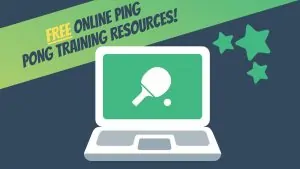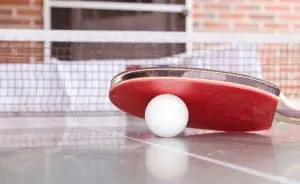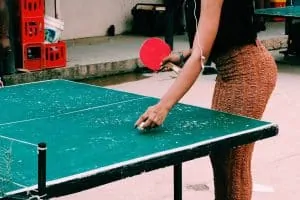Thinking of taking up the game of ping pong? Or maybe you’ve recently acquired a game room space and you’re thinking of adding a ping pong table? Well, it’s music to our ears!
To help you get started on your ping pong journey, we’ve curated the following 10 tips to help you fast track your game.
1. Be prepared to have fun!
If you’ve decided to start playing ping pong, you’re more likely to be in the mindset of enjoying a challenge and having fun. After all the game of ping pong is found in game rooms – sacred places of entertainment – all around the world.
But having the right attitude and mindset is important. For instance, you might not develop a certain skill as easily as you would like, such as returning the ball with a backhand stroke. Rather than give up, it’s important to keep at it. Try alternating techniques and importantly, have fun while trying.
As a beginner, you’re more likely to be challenging friends and family on weekends or holidays. So while bragging rights are important, there’s almost always another occasion you can use to show off your skills.
2. Ensure you have enough space to play
You’ve decided to give the game a go and open to having a bit of fun. What next? Before going out and purchasing any equipment it’s VITAL to make sure you have enough space to play.
A common mistake that many wanna-be table tennis players make is underestimating the size of the room required to play.
It’s recommended, but not essential, that the room is at least 15.5 ft (6.74 m) long and 8 ft (2.5 m) wide. Also ensure you allow about 7ft (2 metres) of height with no lower hanging lights or other objects.
Remember that when you’re playing, players move around from side to side and back and forth while chasing down the ball. So it’s important to have a comfortable amount of space to do this.

If you’re interested in an outdoor ping pong table, you have to consider not only the size of the area but also the weather conditions. This is likely to impact the amount of time you will have to practice.
3. Buy suitable equipment
Ok now that you’ve confirmed your playing area its time for the fun part – getting the right equipment.
As a beginner, you might not know what to look for when buying a ping pong paddle or table and its easy to pick the cheapest or most expensive. You’re also unlikely to notice the difference between an entry level paddle versus a high-end paddle.
At this early stage you should buy a paddle and table that suit your needs, skill level and budget. For instance, you might be happy to pay a little extra for something that may last longer.
We recommend conducting your own research to gain a little understanding of what to look for. We’ve done most of the hard work for you in our review of best ping pong tables and best ping pong paddles for beginners.
4. Find a partner
We’re not talking about a life partner here, just someone that you can play table tennis with! While it is possible to play on your own, it’s much easier and way more fun to play against someone.
Your table tennis partner could be but is not limited to:
- Your life partner
- Brothers, sisters, cousins
- Parents
- Friends
- Neighbours
- A random from the street
Having a playing partner has some advantages but it can also have some disadvantages.
A partner with the same skill level is a good chance for you both to progress your development together. But you’ll need more time to develop and the skills you acquire will be limited.
A partner with advanced ping pong skills can fast track your progress by teaching you correct techniques. However, you may develop the feeling that you’re inferior to them and your confidence level may take a hit.
On the flipside, your partner may also become frustrated at your progress and may consider a break-up.
If a partner is not an option, many tables include playback options or you could buy a table tennis robot which will release balls for you to return.
5. Get a comfortable grip
One of the most important things that a beginner should learn from the outset is how to hold their paddle correctly.
Doing this right from the start can have huge benefits for the development of your game. It also saves re-learning the correct grip at a later time, which can often be tricky and take longer to master.
There are two main types of grip – the penhold and shakehand grip – with shakehand being the most popular of the two.
To hold the paddle using the shakehand grip:
- Place your index finger across the bottom of the backhand rubber
- Position your other fingers and thumb like holding a hammer
- Don’t hold on too tight! The paddle should be comfortable in your hand and have some give.
Here’s a video that provides a great demonstration of how to correctly hold the paddle using both shakehand and penhold grips.
6. Get familiar with different strokes & serving techniques
Stroke play
When you’re first starting out, your main aim is to ensure the ball ends up on the opponent’s side of the table.
You will need to learn the basics of the backhand and forehand. It’s vital to spend time getting the feel of the ball, understand the correct paddle positioning and force to apply, to make an accurate shot.
Some of the key strokes that we recommend learning are backhand and forehand drives, as well as the backhand and forehand push.
Check out these awesome video tutorials on mastering these strokes.
Backhand and forehand drives
Backhand and forehand push
Serving
If you’re intending on playing a match, you’ll also need to know how to serve. There are a range of table tennis serving rules to ensure you serve correctly.
For beginners, we recommend keeping it simple to start.
- Use a short ball toss – to make it easier to connect with the ball in the right spot.
- While the ball is dropping, hit the ball with your paddle.
- The ball will bounce on your side of the table before going over the net and bouncing on your opponent’s side of the table.
7. Keep your eye on the ball
Being a skilled ping pong player requires good hand-eye coordination. So it’s important to keep your eyes on the ball at all times.
It’s easy to get distracted by focussing on the opponents’ grip, their paddle, their body position or the area of the table the ball may or may not bounce.
The ball can move in many directions and different strokes will make the ball move in a certain way. A player should notice the opponents stroke to pre-empt the balls trajectory, pace and if any spin has been added.
However, if you don’t focus on the ball you will not be prepared to select the right stroke and return the ball.
Judging the amount of spin that has been applied to the ball is difficult to determine as a beginner. It depends on several factors, including the opponent’s paddle, the table surface and the opponent’s stroke. This is a skill you will develop over time.
8. Position your body in the right way
During play, you will naturally move your body in a way that helps prepare to return the ball.
Textbooks and table tennis coaches have determined a stance called the Ready position, gives a player the best chance to return a shot.
The ready position is the body position that you should be in when you are receiving the serve or returning the ball.
For right-handed players, they should be positioned slightly on the left of the table. This is to allow for the return to come from their forehand side. For left-handed players, it’s the opposite.
Give yourself enough distance from the edge of the table while holding the paddle out in front of you. You’ll know the correct distance if the paddle is in line with the table’s edge (or your paddle just touches the table edge).
Right-handed players will need to have their left foot slightly forward and their feet about shoulder width apart. As you get better you might find your stance widening to give you a better centre of gravity. Again for left-handed players, it’s the opposite.
Finally, your legs should be slightly bent to allow you to spring to the right or left if a wide shot is played.
9. Practice, practice, practice
We cannot stress this tip enough! You will never have enough practice, although this can be debated. According to a theory Malcolm Gladwell popularized in his book Outliers – 10,000 hours of practice can turn anyone into an expert.
But while many of us will not even get close to half of that playing ping pong, the more practice you can get the better you will be.
There are some basics that we suggest you start with to help your development:
- Focus on returning the ball on the opponents’ side of the table
- Don’t go for too much power
- Stand closer to the table
- Practice just hitting one stroke over and over
- Keep your eyes on the ball!
And while practising remember, that its a game and its meant to be fun! So don’t get frustrated if you’re not making your shots.
10. Join a club or buy professional lessons
If you really want to take your game to the next level and outside of your game room, there are several options you can try.
Online tutorials
There are a bunch of good resources on the internet that give you professional advice and step by step demonstrations. If you like some of the videos in this article, check out the range of online tutorials from Ping Skills.
Join a club
The next best thing to do is join a competitive table tennis club. You will find opponents from all skill levels at clubs and this is one of the most social and easiest way of developing your table tennis skills.
You can find a local club near you by visiting the association websites:
Hire a coach
Finally, you can hire a personal coach to give you one on one training. This is the quickest way to improve your game, but not something that’s recommended for beginners.
A coach could be valuable if you’re looking at taking your game seriously and there were specific aspects that you wanted to work on.



